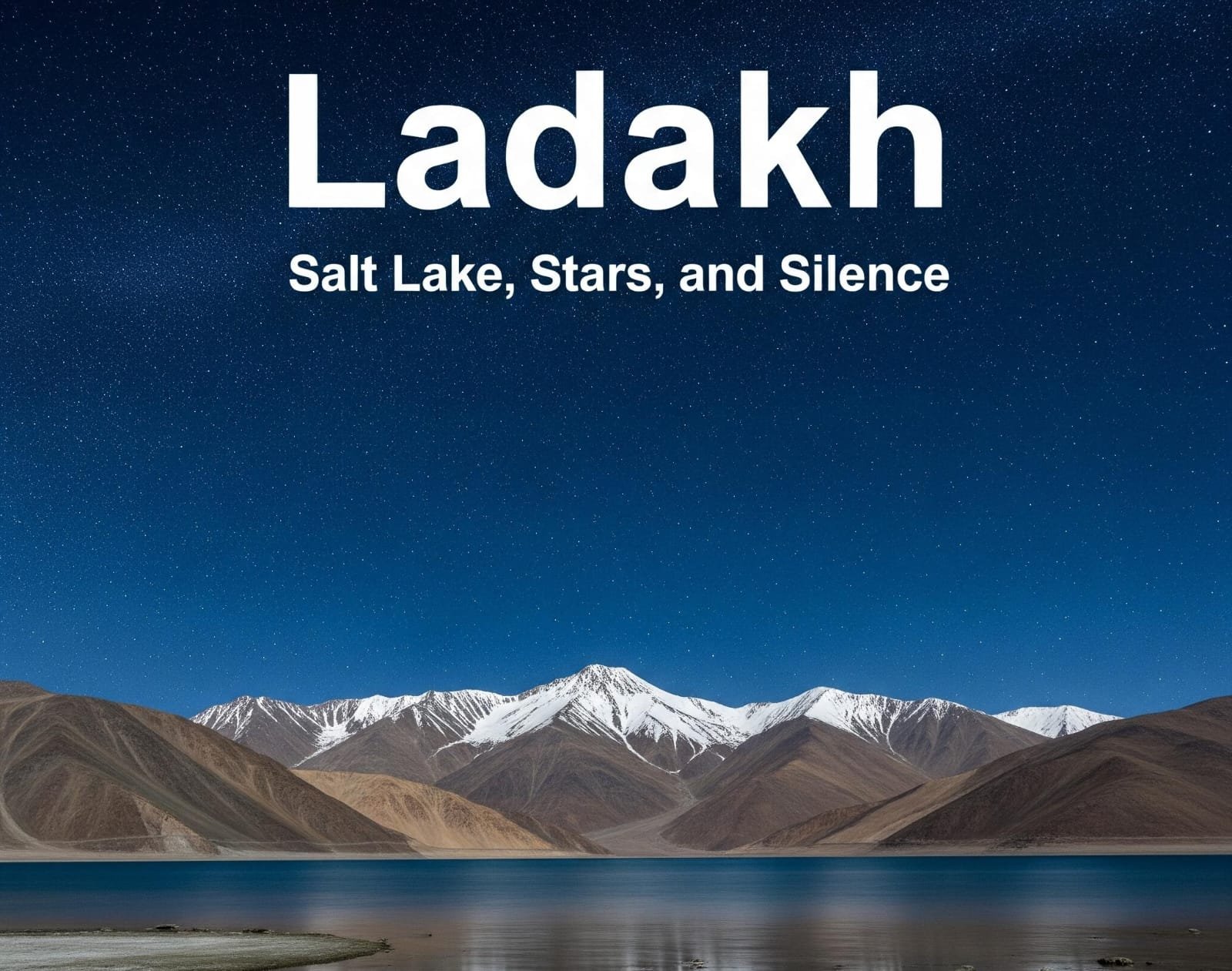I came to Ladakh seeking landscapes, but I found a land of paradoxes. It’s a cold desert that receives less than three inches of rain a year, yet it is home to one of Asia’s largest and highest saltwater lakes. It’s a place of immense, barren emptiness that holds the secrets of the cosmos in its clear night skies. This is not just a travel story; it’s an exploration of the raw beauty, scientific wonders, and the profound silence of Ladakh—a journey that makes you feel incredibly small, and in doing so, helps you grow.
For those planning to explore this high-altitude wonderland, here’s a quick overview. This journey focuses on the remote Changthang region. The main highlights are the magnificent Pangong Lake and the offbeat village of Merak on its shores, the cosmic spectacle at Hanle, India’s first Dark Sky Reserve, and the geothermal wonders of Chumathang. A crucial tip for any Ladakh trip: acclimatization is key. Spend at least two days in Leh before venturing into these even higher altitudes.
Pangong Tso: The Saltwater Ocean in the Sky
The first sight of Pangong Lake is a moment that redefines your understanding of nature. At over 14,000 feet, this 160 km long saltwater lake stretches from India into Tibet, an impossible slash of brilliant blue in an otherwise ochre desert. It’s an ocean in the sky.
I spent hours just watching its moods—the gentle lapping of waves, the way its colour changes from turquoise to deep blue as clouds pass over. This tectonic marvel, known as Tso Nyak in Tibet, is too saline to drink, yet it sustains a unique ecosystem. Watching the sun rise over its still waters, illuminating the distant Kangju Kangri peak, was a spiritual experience. The wind was the only sound, a primal hymn in the vast emptiness.
Merak Village: Life on the Edge of the Blue
While most tourists flock to the main viewpoint, the real soul of Pangang lies in remote villages like Merak. Life here is a masterclass in resilience. The homes are traditional mud-brick structures, insulated with hardy bushes to protect against the harsh winters when everything freezes. It was humbling to learn that consistent water access only reached this village in 2021.
The highlight of Merak was discovering a Rantak—an ancient, water-powered barley mill. I watched, mesmerized, as the force of a glacial stream turned the stone wheel, grinding local barley into sattu. It was a timeless piece of Himalayan engineering, still functioning perfectly. In the local government school, I saw children chanting their morning prayers with a backdrop of snow-capped peaks, a sight of profound beauty and hope.
Hanle: A Journey to the Stars
From Pangong, my journey took me to Hanle, a remote village situated at 14,000 ft. Hanle is special. It is home to India’s first and only Dark Sky Reserve, a place with zero light pollution, making it one of the best sites in the world for stargazing.
As night fell, I stepped outside and looked up. The sight left me breathless. The Milky Way wasn’t a faint smudge; it was a brilliant, dense river of light, strewn across the entire sky. It felt like I could almost touch the cosmos. It’s a deeply humbling experience.
Nearby stands the Indian Astronomical Observatory, home to the Himalayan Chandra Telescope, India’s highest. All the incredible data captured here is sent nearly 3,000 km away to ISRO’s center in Bangalore. I learned that on rare occasions, even the Aurora has been witnessed from here—a testament to the pristine clarity of Hanle’s sky.
Chumathang: Where the Earth Breathes Fire
My final stop was the surreal landscape of Chumathang. Here, the Earth itself feels alive. Boiling geothermal springs gush out of the ground, their steam creating a misty, otherworldly atmosphere in the cold, dry air. I could feel the heat radiating from the ground and even see small rocks trembling from the immense pressure of the water emerging from deep within the Earth’s crust. It was a powerful, visceral reminder of the raw geological forces that have shaped this incredible land.
A Conscious Traveler’s Guide to Remote Ladakh
- Go Beyond the Main Spots: To truly experience Pangong, stay in an offbeat village like Merak or Spangmik. You’ll witness a more authentic way of life and have the lake almost to yourself during sunrise and sunset.
- Stay Overnight in Hanle: A day trip is not enough. You must stay the night to witness the celestial magic. Book a simple homestay and prepare for a cold but unforgettable night.
- Visit Chumathang in Daylight: The geothermal area is unfenced. For safety, it’s best to visit during the day when you can clearly see the hot water springs.
- Embrace the Disconnect: There is little to no mobile network in these areas. Inform your family, download offline maps, and enjoy the peace.
- Travel Slowly and Respectfully: Acclimatize properly. Support the local economy by staying in homestays and buying local products. This is a fragile ecosystem; leave no trace behind.
A Final Reflection
Ladakh is not a destination you conquer; it’s a universe that you enter. It teaches you about the science of our planet and the scale of our cosmos. It shows you the resilience of life in the harshest of conditions. Standing under the vast, star-filled sky of Hanle, I felt my own significance shrink to almost nothing.
And under this sky, we shrink, and that’s exactly when we begin to grow.

Leave a Reply